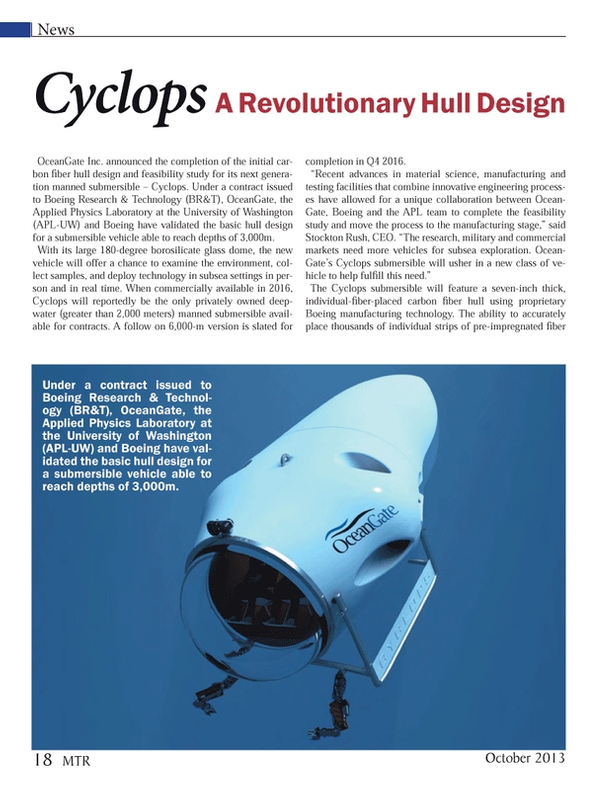
Cyclops: A Revolutionary Hull Design
OceanGate Inc. announced the completion of the initial carbon fiber hull design and feasibility study for its next generation manned submersible – Cyclops. Under a contract issued to Boeing Research & Technology (BR&T), OceanGate, the Applied Physics Laboratory at the University of Washington (APL-UW) and Boeing have validated the basic hull design for a submersible vehicle able to reach depths of 3,000m.
With its large 180-degree borosilicate glass dome, the new vehicle will offer a chance to examine the environment, collect samples, and deploy technology in subsea settings in person and in real time. When commercially available in 2016, Cyclops will reportedly be the only privately owned deep-water (greater than 2,000 meters) manned submersible available for contracts. A follow on 6,000-m version is slated for completion in Q4 2016.
“Recent advances in material science, manufacturing and testing facilities that combine innovative engineering processes have allowed for a unique collaboration between OceanGate, Boeing and the APL team to complete the feasibility study and move the process to the manufacturing stage,” said Stockton Rush, CEO. “The research, military and commercial markets need more vehicles for subsea exploration. OceanGate’s Cyclops submersible will usher in a new class of vehicle to help fulfill this need.”
The Cyclops submersible will feature a seven-inch thick, individual-fiber-placed carbon fiber hull using proprietary Boeing manufacturing technology. The ability to accurately place thousands of individual strips of pre-impregnated fiber will overcome many of the hard to control variables surrounding traditional filament winding processes and permit the hull to withstand the very high compressive loads at 3,000m (300 bar).
The use of carbon fiber will also help make Cyclops significantly lighter, making deployment faster, easier and more cost-efficient. While in the water, Cyclops’ five crew members can comfortably observe the ocean depths through a massive glass dome, which offers unobstructed views for at-depth inspections, environmental assessments, discussion, decision making and observation.
Cyclops eliminates the tethering limitations of ROVs and allow its five crew members to observe underwater environments for up to eight continuous hours. Using a patent-pending submerging Launch, Retrieval and Transport (LRT) platform, OceanGate can operate a manned vehicle with ships of opportunity at much lower costs than most other manned vehicles and, in many cases, even less expensively than ROVs. With the ability to be quickly and affordably deployed around the world, Cyclops will usher in a new generation of oceanic exploration and study.
oceangate.com
(As published in the October 2013 edition of Marine Technology Reporter - www.seadiscovery.com)
Read Cyclops: A Revolutionary Hull Design in Pdf, Flash or Html5 edition of October 2013 Marine Technology
Other stories from October 2013 issue
Content
- Increase in Demand for the Hot Subsea Vessel Market page: 8
- Oceaneering Taps BAE Systems to Build New Subsea Support Vessel page: 12
- Van Oord Contracts Damen for DP2 Cable Laying Vessel page: 14
- MHI to Build RV for JAMSTEC page: 14
- OSD-IMT Wins Contracts for COSL page: 16
- IHC Merwede Launches Pipelaying Vessel page: 17
- Cyclops: A Revolutionary Hull Design page: 18
- Floating LiDAR System page: 20
- Satellite Images Capture Tanker Pollution page: 21
- Baltic Wind Success Paves Way for Ecosse page: 23
- National Ocean Policy, Coastal & Marine Spatial Planning Raising Red Flags page: 24
- One-on-One with SMAST’s Steven E. Lohrenz page: 26
- From Learning to Earning page: 30
- AUV Deployment by the U.S. Navy 5th Fleet page: 36
- ICTINEU 3 Development of a Research Submersible page: 38
- ARGUS Enviable Technology, Unlimited Potential page: 42
- Improved eBird page: 52
- New Additions to Imagenex Line page: 52
- AMEC Buys AXYS Sensor page: 52
- The Cavidome page: 52
- GE Dynamic Positioning page: 53
- Seatronics, CodaOctopus Agree page: 54
- Shark Eye page: 54
- CTI SonarWiz Update page: 54
- Compact Survey AUV page: 55
- New NEXUS HD Multiplexer from MacArtney page: 56
- Tritech’s RAMS Integrity Monitoring Technology page: 56
- Mustang Launches Ocean Commander Immersion Suit page: 56
- Reservoir Modeling Platform page: 56
- MacArtney Inline Termination for Andritz Hydro Hammerfest page: 57
- EIVA: New Winch Range page: 58
- MetOcean Snow Beacon page: 58
- Free Web-Embeddable Map Widgets page: 58


